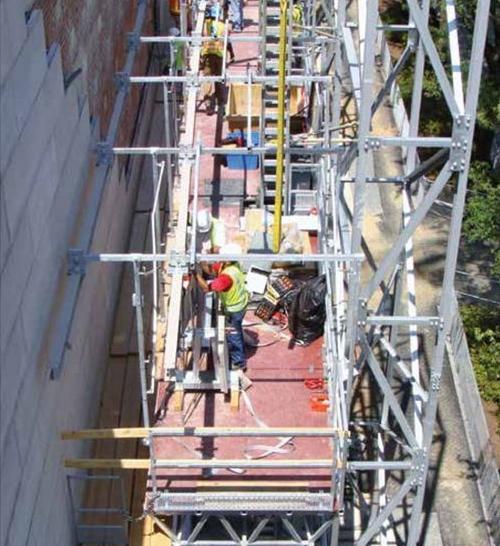
Contractors planning a project to remove and remount all 16,200 of the stone panels that make up the mortarless floating curtain wall on the National Gallery of Art in Washington, D.C., faced an unusual challenge. They had figure out how to remove the 5'x2', 438-lb. panels, install a stronger anchor for each one, and then re-mount every panel in its original spot—without using the building’s face to support any work platform.
Although the most efficient way of doing the work appeared to be using mast-climbing work platforms, that method faced a major hurdle. On most jobs, the masts that support mast-climbing work platforms are themselves supported by being tied into the wall of the building on which they are being used. So this project’s firm requirement that nothing tie into the face of the building except at the top of the wall appeared to rule out the use of mast-climbing work platforms.
Looking for a solution, the project’s general contractor, a joint venture of Smoot Construction Co., Columbus, Ohio, and Balfour Beatty Construction U.S., Fairfax, Va., turned to sibling companies TNT Equipment, Columbus, Ohio, and Premier Scaffold Solutions, Apopka, Fla. Analyzing the project’s requirements, TNT and Premier calculated that working with the heavy stone panels would require their 20,000-lb. capacity, two-towered ProSeries mast climbers, each equipped with two monorail systems for moving the stone.
To meet the requirement that nothing tie into the face of the building, TNT, Premier, and the Smoot-Balfour Beatty joint venture engaged in some creative, out-of-the-box thinking. They literally backed into the answer by designing a way to set up the mast-climbing work platforms backward, with their fronts facing away from the building.
Innovative solution
To replace the stability normally provided by tying into a building, each mast was connected to a specially engineered structural-steel support called “the backbone,” whose base was mounted to concrete pads and top was tied to the top of the building walls. The creative configuration allowed beams extending from of the back of the mast climbers to reach next to the building’s floating curtain wall without being supported by it. Reversing the platforms also required TNT and Premier to design special guardrails for the work area near the building.
“I have worked with mast climbers for 17 years, and I’ve never seen this before,” said Michael Solomon, national sales manager and training director for both TNT and Premier. In all, TNT/Premier has had up to 21 ProSeries mast climbers working on the project at once. Modular bridging, an option for ProSeries mast climbers, connects each work platform to those on either side.
Each mast climber has a double monorail system to simplify handling of the heavy stone panels. “We designed the monorails so that two I-beams run the length of each mast climber’s platform and the modular bridging,” said Solomon. “The monorail brackets adjust out from the mast climber to the wall in order to accommodate differing shapes and the amount of decking planks needed.”
Workers use one monorail’s trolley chain hoist to take stone slabs from the wall and then later to re-mount the refurbished ones. “The second monorail beam is located more towardthe middle of the platform,” explains Solomon. “It is used to move the stones horizontally on the deck.” Specially designed stone carriers mount on the monorail hoists to help assure the stones are moved safely and protected from damage.
Each stone is lowered to the ground by a hoist or a crane, and then taken to an on-site stone shop for refurbishing, followed by storage in racks until it is returned to the building and mounted on a new anchor. “The whole process is meticulously organized and very efficient,” said Solomon. “It runs in a continuous cycle, with panels coming off and panels going back on in a steady stream. Each panel is barcoded as it is taken off the wall so it can be tracked and re-mounted in exactly the same spot.”
Throughout the project, safety has been paramount, according to Solomon. TNT erected the entire system and will dismantle it at the project’s end. Before the equipment was turned over to work crews, a complete safety class was performed on site many times to ensure everyone was able to access and operate the ProSeries mast climbers safely. In addition, the site was vetted by OSHA compliance officers, whose office sits just across the street. Solomon and another expert even gave OSHA representatives an on-site presentation to educate them about mast climbers. Solomon estimates that more than 45 workers are currently atop the project’s mast climbers to remake the floating curtain wall.
The access provided by Premier’s mast climbers and the efficiency of the whole reconstruction system are saving lots of time on the project. Solomon says Smoot and Belfour Beatty’s pre-planning paid off greatly for this job. “This project started in March 2011 and was planned as a three-year job,” Solomon noted. “It now looks as though it will be complete in the summer of 2013, at least six months early.”